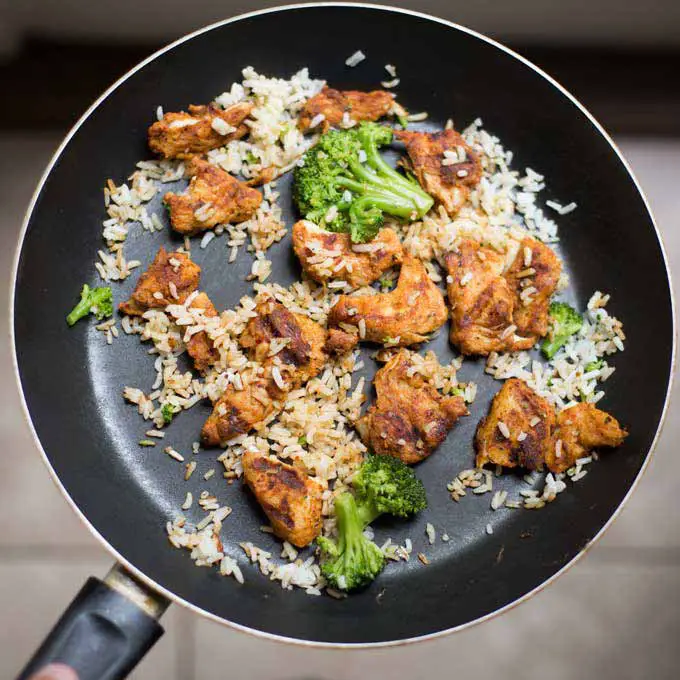Non-stick skillets have been a polarizing topic in the kitchen for the last few years. Many cooks swear by their ability to cook perfect eggs that slide off the pan gracefully. Others are concerned about the potential effects of chemicals once used in the making of non-stick pans. No matter which side of the debate you are on, it is hard to ignore the benefits of non-stick cooking. The skillets can be affordable, easy to clean and use less oil and butter required when cooking in other skillets. But how do you choose which style is right for you?
Choosing the Right Non-Stick Skillet
The three main types of non-stick cookware are traditional, porcelain-enameled and ceramic-coated. I’ll outline all of them and focus on the benefits and drawbacks of ceramic-coated non-stick pans. Finally, I will give you the top 5 non-stick skillets available on Amazon.
Traditional Non-Stick
Traditional non-stick skillets typically have a black interior and require very little (if any) oil or butter to cook with. Most of the time, additional oil or butter is added for flavor, not to aid in the non-stick process. These types of pans vary in cost and quality - ranging as little as $20, all the way up to a few hundred dollars. They are great conductors of heat and allow for hassle-free cooking of eggs, omelettes and crepes.
There have been safety concerns with theses types of non-stick skillets, but recently, companies have found alternative materials to create non-stick surfaces without harmful chemicals.
Safety Concerns of Traditional Non-Stick
True non-stick pans are treated with the chemical compound PTFE, also known as Teflon. During the 1960’s, the first Teflon-coated cookware was available for sale. PFOA is another man-made chemical used in the process of making Teflon. The compound is safe for humans, but if exposed to temperatures above 500ºF, the molecules in PFOA can start to breakdown, potentially releasing harmful gases to the human body.
Many non-stick skillets today are made without these chemicals, so be sure to look for “PFOA and PTFE Free” on the label when buying any type of non-stick cookware.
Porcelain-Enameled
Porcelain-enameled pans have a coating baked on during the production process, creating a glass surface on the interior of the pan. These pans can last a long time, if properly cared for. Porcelain-enamel pans are an eco-friendly option and can be an affordable choice for a non-stick pan.
Ceramic-Coated
The last type of non-stick, and the focus of this article, is ceramic-coated skillets. This option is a newer alternative in non-stick technology, in response to the potential negative side-effects of using non-stick cookware made using PTFE (Teflon.) These type of pans have a brittle, smooth and hard surface. They are non-toxic, easy to clean and affordable skillets to add to your kitchen arsenal. The pans can be a bit fragile, and can lose some of their non-stick qualities over time, if not cared for properly.
Each of these types of non-stick skillets can be a great addition to your kitchen, but this article will focus on helping you find the best ceramic-coated non-stick skillet.
What makes a Ceramic-Coated Skillet?
Most ceramic-coated pots, pans and skillets are made from anodized aluminum or stainless steel, then coated in a layer of ceramic.
Benefits of Ceramic-Coated Skillets
There are many benefits to using a ceramic-coated skillet in your kitchen.
First, the skillets are very easy to clean. Since food normally should not stick to the pan, cleaning is a breeze.
Second, Since the core of the skillets are usually made of aluminum or stainless steel, they can work with a variety of cooktop surfaces.
Third, while most non-stick skillets have removed the harmful toxins that once were present in non-stick skillets, ceramic-coated skillets have always been manufactured without PFOA, thus making them a safe choice.
Drawbacks of Ceramic-Coated Skillets
Because of the ceramic coating, most companies will recommend that you not use metal utensils when cooking with these skillets. The ideal tools would be wood, plastic, silicone or nylon. Once you get in the habit of not using metal utensils, this drawback should not affect your decision too much.
Another minor drawback to ceramic-coated skillets is that they should not be put in the dishwasher. While the manufacturer may say that they are dishwasher safe, hand-washing will keep the pan in the best form for a longer period of time.
Durability and the longevity of the non-stick coating is one of the biggest drawbacks of purchasing a ceramic-coated skillet. If not well-taken care of, the non-stick component of the skillet could wear off within the first year. Caring for your ceramic-coated skillet is one way to keep its surface non-stick and prolong the life of your skillet.
Tips for Caring for Your Ceramic-Coated Skillet
There are many things you can do to keep your ceramic-coated skillet as non-sticky as you can.
Handwashing is the recommended way to care for your ceramic-coated skillet. Use warm soapy water and a soft sponge to clean.
Thermal shock can be a detriment to ceramic-coated skillets. Thermal shock is the drastic change in temperature, like taking a hot pan and plunging it into cold water. This can damage the non-stick coating of the skillet. Allow the pan to cool down before washing. Also, removing your food from the refrigerator at least ten minutes before cooking to take some of the chill off will help protect against thermal shock.
If you need to use some oil in the pan, only use a tiny amount, just enough to lightly coat the cooking surface. Avoid using cooking sprays as they can build up over time on the cooking surface.
Avoid using metal utensils with your ceramic-coated skillets as these can scratch the surface. Use wooden, silicone, plastic or nylon utensils instead. They will protect the coating and extend the life of the pan.
When storing your ceramic-coated skillet in a nesting or stacking fashion, lay a paper napkin or towel in between skillets to protect the cooking surface.
Considerations to Make Before Purchasing your New Ceramic-Coated Skillet
Budget - Skillets can have varying price points. While higher priced items generally are made with more durable materials, there are many great ceramic-coated skillets that don’t cost much.
What kind of cooking you do - Do you make eggs, omelettes, crepes or other food items that benefit from a high-quality non-stick pan? If so, choosing a skillet that will stand the test of time is an important factor.
Lids and Handles - Not every ceramic-coated skillet comes with a lid. Many times, this is a non-issue, but can be a factor if you like cooking in a skillet with a lid. Most ceramic-coated skillets are able to withstand higher temperatures, but not every skillet’s handle is oven-safe. If you plan on using the skillet in the oven, consider whether or not the handle will remain cool in the oven.
Top 5 Ceramic-Coated Skillets available on Amazon
Now that you’ve decided you want to purchase ceramic-coated skillet, here are five of the best ceramic-coated skillets you can purchase on Amazon.
1. Vesuvio Ceramic Coated Non-Stick Frying Pan
Pros
Cons
Pros
Cons
Pros
Cons
4. GreenLife Soft Grip Ceramic Non-Stick Frypan
GreenLife boasts an affordable price point, with many great features of higher priced skillets. This 12-inch pan is oven and dishwasher safe, along with a stay-cool handle.
Pros
Cons
Pros
Cons
Check out the buying options for this pan on Amazon
Takeaways
While a ceramic-coated non-stick skillet is a great tool to keep in your kitchen, it seems inevitable that most products will eventually lose some of their non-stick quality over time. These pans will not likely become family heirlooms that get passed down from generation to generation.
Even with proper care techniques, ceramic-coated skillets will only last a few years. Understanding that the pan you purchase may need to be replaced should factor into the final purchase decision.
For more review articles, check out our Kitchen Tools section.






